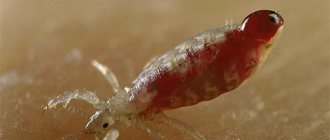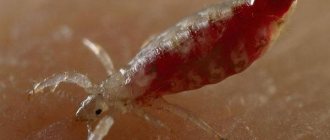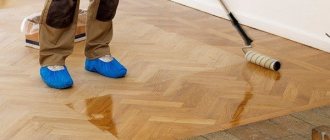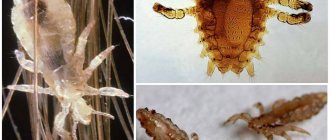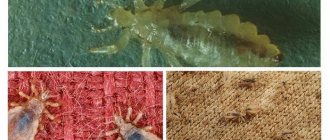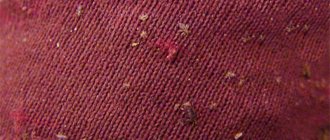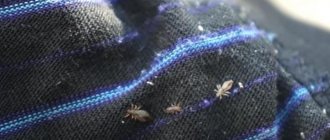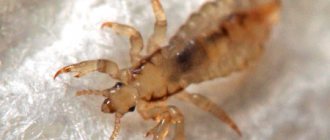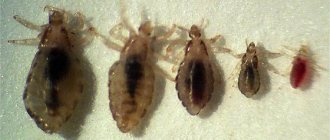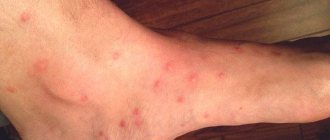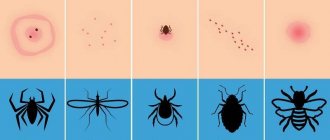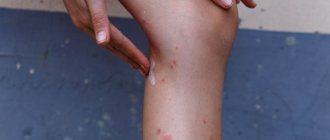What do bites look like?
One of the “signposts” of an unpleasant neighborhood is the detection of traces of insects. For this reason, it is important to know exactly what the skin lesions left by linen, bed and body lice look like.
Believykh
Linen lice bites are localized in areas of slight hair growth - lower back, buttocks, neck, upper back, abdomen. During the feeding process, the insect moves throughout the human body, moving away from the previous site of the lesion. For this reason, traces of pests are located in groups, but do not form a “path”.
The site of the skin lesion turns red and swells. When in contact with items of clothing, the spots begin to itch. When scratched, they become dense and ulcers appear.
The wounds take a long time to heal. Unlike an allergic rash, the redness of the skin does not subside after using antihistamines. To get a good look at what a bite from linen lice looks like on the body, you should arm yourself with a magnifying glass - this is a common spot on the skin with a black mark in the middle.
Video
What do bed bug bites look like?
Bed
The bed louse is not interested in the hair area of the human body. Unlike its relatives (pubic and hairy individuals), the bed parasite is larger in size - 3-5 mm.
Most bed lice bites occur in the armpits, on the hips and lower back, between the shoulder blades, and on the neck . The lesions are not localized in a specific way; they are located chaotically and are presented as single swellings with a dot in the center.
After saturation, the parasite turns red-brown, increases in size and begins to resemble a flea.
Clothes
Body lice bites cluster around the neck, waist, upper back, armpits, groin and abdomen. Externally, the affected area is similar to a bed lice mark. Over time, single spots on the body become bluish.
Where can you get lice?
In an age of constant population migration, it is easy to become a victim of laundry parasites. Therefore, you need to know where these bloodsuckers can bite a person:
- they usually live in bedding and pass through it to a new owner;
- reach the victim through the clothes of another person;
- often public places with large crowds of people are a risk zone where infestation with linen lice can occur.
Such objects are:
- clothing stores - fitting rooms;
- campsites, hotels, motels, hostels;
- all places of public recreation: children's, sports and tourist camps, sanatoriums and recreation centers;
- public and private transport;
- overnight stay in one tent during hiking trips;
- at a party or in places where there is contact with other people's bed linen, clothing or towels.
How lice bite
Answering the question of how bed lice bite, you can give a similar answer to the question regarding other types of insects. The principle is identical : the parasite’s mouth is made up of jaws that resemble stilettos.
By biting, the louse pierces the skin with the help of its jaws and injects a little enzyme into the resulting wound, which prevents human blood from clotting. It is this substance that causes irritation, itching and redness at the site of the lesion.
Once the integrity of the skin is broken, the insect begins to search for an artery, which will become a source of nutrition. The pest sucks, clinging as closely as possible to the human body - its back part rises slightly.
The adult repeats the meal every 2-3 hours. After finding out how linen lice bite a person, it is worth moving on to the logical section on the correct treatment of lesions.
Methods of infection
You can become the owner of a linen parasite while traveling on public transport, a train, or when visiting a hotel or medical facility. It is not difficult to become infected with lice in a swimming pool, a tent camp or at a transshipment base. The likelihood of infestation with linen lice is especially high in areas for people who do not have a specific place of residence. This is not a rare phenomenon among prison inmates, as well as army employees.
Products for treating bites
In most cases, you can cope with the symptoms of an insect attack on your own. The help of a specialist is necessary if a clear allergic reaction occurs - a person’s temperature rises, chills, headache, nausea, etc.
As part of the question of how to treat lice bites from linen, bed and clothing lice, it makes sense to consider the features of the use of medicines and folk remedies
Medicines
At home, parasite stains can be treated as follows::
- any ointment containing hydrocortisone (relieves swelling and discomfort after a bite);
- hydrogen peroxide (has antiseptic properties);
- homeopathic medicines (with tea tree oil, calendula);
- Fenistil gel (relieves severe itching).
If the patient develops purulent formations indicating the development of an infection, the patient may require antibiotic therapy (Doxycycline, Lincomycin, etc.) as prescribed by the doctor.
Other medications prescribed by the doctor include the antiseptics Miramistin, Chlorhexidine, antihistamines Zodak, Suprastin, etc.
Universal products will help you get rid of linen, bed and clothing lice.:
- Paranit;
- Pediculen;
- Para Plus and others
Folk remedies
Folk help for lice bites is also appropriate.
Among the possible “helpers” in eliminating the primary symptoms of insect bites:
- soap solution. Helps relieve the first unpleasant symptoms, disinfects;
- alcohol or vodka diluted with water in a 1:1 ratio. Disinfects and prevents infection from penetrating into the deep layers of the dermis.
Frequently asked questions (FAQ)
Lice and the consequences of infection with them give rise to many myths and questions that are not always easy to answer. Below are answers to the most common questions.
Expert opinion
Alexandra Valerievna
Doctor-Trichologist
The most common question people ask is: Do nits bite?
The answer is negative, since a nit is a larva located in a dense window. They cannot leave the cocoon and live solely on the nutrients already available until they hatch. Also, nits are not capable of moving on their own and are usually attached with a special solution to hair or tissue, where they will mature for several days before hatching.
What do pubic lice bite marks look like in men?
Bites in men are not much different from those in women. Another thing is that they are more difficult to notice, since men shave their pubic hair much less often, and the hair in their groin area is much denser. These factors prevent the detection of bite marks even at a severe stage of infection.
Is it possible to get lice on public transport?
Yes, it's unlikely, but still possible. Transmission of lice, especially head lice, most often occurs in public places where there are large crowds of people. Other potential risk areas are dormitories, kindergartens, schools and other places where close contact between people is expected in one way or another.
Are there any precautions?
Do not wear someone else's clothes, even if you know the person well. Do not use other people's bed linen. The exception is, perhaps, freshly washed and initially separately packaged bedding items on Russian Railways trains. Limit the number of sexual contacts on the side, since there is no guarantee that your partner does not have lice or sexually transmitted diseases.
What can be the consequences of bites?
In addition to the already mentioned discomfort, the possible development of allergies and diseases, there is only one side effect. With prolonged infection, scars may appear at the site of the bites, since the skin has been damaged for a long time. In most cases, scars are invisible, as they are either under clothing or hidden by hair. But the elasticity of the skin in these places will be impaired, as well as its heat exchange.
Should we panic?
In any case, there is no need to panic. Take sick leave so as not to spread the infection further, and then begin treatment. If you feel unwell, consult a doctor to avoid a possible allergic reaction and diseases carried by lice. Basically, this parasite is harmless and easily expelled.
- about the author
- VK profile
How to distinguish lice bites from other insect bites
Single bites of clothing, linen and bed lice are very easily confused with the site of a bite, for example, of a bedbug.
There are some "landmarks" that can help identify the pest.:
- The louse leaves behind chaotically “scattered” spots, unlike the bug. The latter tries to bite at a distance of several centimeters - a “chain” of spots is obtained.
- An insect bite differs from the lesion left by a flea in the absence of obvious pain at the time the skin is damaged. If a flea bites, this process is accompanied by intense pain. He learns that a person has been bitten by a louse several hours after contact. In addition, fleas often leave visualized “tracks” on the victim’s body.
- Ticks, unlike lice, leave behind a large area of damage (a swollen red circle). To eliminate the feeling of hunger, the tick needs to eat from several hours to several days; lice do not eat for that long.
- Mosquito bites differ from marks on the body left by lice in the absence of a darkened hole in the center in the affected area.
In some cases, insect marks are confused with manifestations of scabies, which is caused by scabies mites. However, in this case there are no visible traces of skin puncture at all.
Symptoms of lice and how the patient feels
When there are a large number of linen lice, their bites cause a disease called pediculosis. Its symptoms are much more extensive and distinct than the signs of single bites:
- Red, dry rashes all over the body, even in areas where there are no bites. This rash is itchy and painful when scratched. The photo shows erythematous rashes caused by linen lice bites:
- The resulting excoriations are small local self-injuries of the skin in the form of small scars. They look like healing scratch bites, but can also occur where lice have not bitten at all. Quite deep scars later appear at the site of excoriation.
- Blue pigment spots at the bite sites. This is a fairly characteristic symptom that rarely develops even as a result of allergic reactions to the bites of other insects.
- In places with accumulations of bite marks, boils and ulcers appear, which, if left untreated, develop into pyoderma. The photo below shows advanced pyoderma caused by linen lice bites.
- Symptoms of “tramp disease” are roughening, thickening of the skin, excessive pigmentation and darkening.
However, the symptoms of lice are usually characteristic of people who have not gotten rid of linen lice for years and live in unsanitary conditions - tramps, refugees, prisoners in camps in the tropics. The development of lice is preceded by such obvious and unpleasant symptoms of parasite attacks that, if possible, a person gets rid of lice even before serious damage develops.
Danger of bites
The danger of bites from linen and other types of lice lies in the likelihood of a person becoming infected with dangerous diseases. The infection process takes a few seconds.
Among the pathologies carried by lice:
- relapsing fever (manifested by skin redness, intoxication of the body, attacks of fever);
- typhus (occurs against the background of destructive vascular changes);
- Volyn fever (manifests as acute pain in muscles, bones) and others.
Bites from body lice and other types of lice can also cause an acute allergic reaction, which in some cases leads to anaphylactic shock - the patient needs urgent medical attention.
For this reason, if suspicious spots appear on the body, it is necessary to promptly exclude linen lice bites.
What is a body louse
This type of lice is a close relative of head parasites, but differs only in that it can remain outside the victim’s body for a long time and calmly continue its life activity on clothes, sheets and blankets. These subspecies of blood-sucking insects mix with each other.
Linen lice
Interesting!
The fossilized lice and nits found date back approximately 10 million years. The linen louse became an independent subspecies much later. This happened about 100,000 years ago. The reason for this split among relatives was the fact of the appearance of the first clothes. These insects were so widespread in the world that to this day in all languages there are curses associated with the mention of these parasites.
Preventive measures
Preventing the spread of lice involves regularly checking suitcases upon returning from a business trip or traveling, and washing stale items of clothing.
To protect yourself from insects, you can put a cotton pad soaked in hellebore water or lavender oil in the closet with your linen. You should visit beauty salons and hairdressers with caution and pay attention to the disinfection of instruments.
Lice live in the folds of people's clothing, bedding and other textile household items. Pests can be detected not only visually, but also by the appearance of bites on the body of household members.
The affected areas are presented in the form of red swellings on the skin, which are characterized by a chaotic location. The bites itch, and ulcers remain at the scratch site.
Medical care for those affected by the active life of parasites should be followed by no less active pest control. You can carry out all the necessary activities yourself or contact specialists.
How to deal with a pest
The fight against linen lice involves not only compliance with hygiene standards, but also the treatment of clothing. Parasites will not bite the body if the following procedures are carried out.
- On a clean and dry body, wear underwear washed at maximum temperature using disinfectants and steamed.
- Washed clothes are left to “fry” for several days under the open rays of the sun.
- You can also use dry cleaning services to process items in a steam-formalin chamber.
- Clothes made from fabrics that cannot be treated at high temperatures are placed in the freezer (temperatures below 15 degrees are detrimental to parasites). The low temperature method will give positive results if used for a week.
Effective treatment
The most effective and safe means include “Paranit”. Its action is to block the respiratory system of lice and nits. The active substances dimethicone and mineral oils have no effect on humans, but are harmful to insects.
Advantages of the product:
- • the result has been confirmed in clinical trials and experience in various countries;
- • the possibility of using the “Paranit Sensitive” product for hair treatment in children over 1 year of age and pregnant women;
- • available in various forms – shampoo, lotion, spray – it’s convenient to choose the best option
- • in most cases, one application is sufficient to eliminate lice;
Linen lice: photo, characteristics, living conditions
An interesting fact is that linen lice are gradually evolving into an independent species, currently being a subspecies of head lice and having the ability to mate with them. They only live on certain types of fabrics, for example, they will never live in clothes made of wool, and all due to the fact that people do not wear woolen clothes directly on their bodies. Also, these insects really do not like silk and other smooth clothes, but they will feel comfortable on cotton and linen.
These insects live only on humans; animal blood is not suitable for them. They are not able to go without food for a long time; a day of hunger can become a critical time for them. In order to always have the opportunity to eat, insects are constantly near the human body in order to immediately have a snack as soon as the need arises, and it occurs about 5 times a day. By the way, one of the main methods of removing head lice is based on their fasting. If the clothes that these insects have chosen as their home are not worn within 5 days, the parasites die.
People whose wardrobe is quite diverse have reliable protection against infection by these insects, because even if a louse accidentally gets on an item of clothing, it may well die while the person is not using it. From this we can conclude that linen lice are permanent residents on the clothes of homeless people and other asocial elements. A declassed lifestyle is a guarantee of infection with linen lice.
Head lice prognosis
The use of effective anti-lice drugs and their proper use leads to a complete cure of lice.
Relapses of the disease are associated with an incomplete course of treatment and re-infection. RELATED LINKS
- Signs of meningitis in adults
- What is pyoderma
- Linen lice
- human louse
- All about diseases of the scalp (photo)
- Remedy for lice and nits for children
- How to get rid of lice and nits
- Causes, prevention and measures to combat pediculosis
Articles in the section “Pediculosis (lice)”
- Signs and symptoms of lice in adults and children
Most popular
- All about foot fungus: symptoms and effective treatment with modern drugs
- Scalp fungus: how to recognize and treat
- Symptoms and treatment of fingernail fungus (onychomycosis)
- The benefits and harms of E. coli
- How to treat dysbiosis and restore microflora
Articles in the section “Pediculosis (lice)”
- All about the prevention of head lice
About germs and diseases 2020
Danger and possible consequences of infection
Body lice are dangerous due to the following consequences:
- Night sleep disorder.
- Decreased concentration.
- Anxiety.
- Violation of the integrity of the skin and the appearance of purulent wounds on them.
- Skin roughening - the insect injects a substance under the skin that reduces blood clotting. If the bite occurs several times in the same place, excessive accumulation of melanin occurs. The area of skin becomes rougher, changes color, and begins to peel off.
- Allergy to saliva and other insect waste products.
- Folliculitis, eczema - the result of scratching bites.
Lice are carriers of Volyn fever, tularemia, and typhus . Of course, nowadays these diseases are very rare, but they still should not be excluded.
Important! Diseases such as AIDS and viral hepatitis cannot be tolerated by lice.
Causes of insects
Linen or body lice are one of the most common subspecies, which are collectively called Pediculus humanus corporis. These are the closest “relatives” of pubic and head parasites that live among human hair. They cannot be constantly on the skin, preferring to settle in colonies on clothing. Favorite places are tight seams, folds and borders. Most often, the parasite is detected on natural fabrics with a high content of wool or linen thread.
The body louse, like the head species, is miniature in size, reaching no more than 3 mm in length. The long and translucent body is difficult to discern among the hair or particles of the epidermis. They do not have wings, but develop a unique jumping ability, which allows them to quickly migrate to new areas. You may encounter them in the following situations:
- In close contact with an infected person (intimate contact, hugs).
- When using someone else's clothes, dressing gown, T-shirt.
- In cramped transport, at work in a team.
- When placing an infected item on a common hanger or closet.
- In the pool, public sauna, during procedures in the hospital.
Fans of hotel holidays are familiar with bed lice, whose bites ruin their holiday. They should not be confused with bedbugs: insects differ not only in size, but also in the method of destruction, processing of skin and surrounding objects.
Important! Lice easily tolerate the absence of food for several days and remain viable when transporting packaged items. Therefore, it is not always possible to establish the source of infection or associate it with a trip or personal meeting.
Linen lice larvae
Linen lice larvae feed only on blood, so they can be found in the same places where adult lice live.
- Insects attach eggs, called nits, to the fibers of the fabric they live on or to hairs on human skin.
- Only the hatched larva measures less than 0.5 millimeters.
- After molting, the larva acquires the features of an adult insect and gradually grows in size.
- At the larval stage, the insect has a color from dirty yellow to brownish-transparent.
Methods for combating body lice
Poisoning individuals is the only method of effectively combating them. But before you begin these measures, you need to thoroughly wash your body using special shampoos - NOC, BUBIL, Veda-2 work well. This will ensure that you cleanse your body of living parasites. After a thorough bath, you can begin the laundry treatment procedure. At home, this process occurs in several stages.
- All items that are contaminated and that you have used are boiled in any container for 20 minutes. To make the result more reliable and effective, and for parasitic linen lice to disappear 100%, you can add special compounds to the water - KARBOFOS.
We boil linen from lice
- If you need to remove linen lice from only one piece of clothing, and you have to get rid of a few individuals, you can simply hang the clothes out in the air in direct sunlight for a week, during which time the individuals will die of starvation. After removal is completed, it is enough to wash the clothes thoroughly.
- If body lice has reached an advanced stage, to get rid of parasites 100%, it is necessary to treat the clothes in steam-formalin chambers, through which any pests can be destroyed. Typically, such cameras are used in wholesale trade in second-hand stores and dry cleaners.
Steam-formalin chamber for disinfection of clothes
Fighting these types of parasites is easier if you know how to remove them and do it at home.
Effective clothing treatment products
Linen lice bites will no longer bother you if you take steps to get rid of them. The most reliable folk remedy for fighting uninvited guests is kerosene, in which the laundry is soaked and then subjected to boiling at a temperature of 100 degrees. The pests will die from these manipulations. The disadvantage of this method is the difficulty of getting rid of the smell of kerosene on clothes, which is why anti-lice medications are increasingly being used today. Linen lice, whose unpleasant bites have become boring, are removed using several methods.
- MEDIFOX is a well-known remedy that helps to quickly get rid of lice, thanks to the insecticide it contains. The product is safe for humans, but has harmful consequences for parasites.
- Hygia is an analogue of the previous drug and is made on the basis of a similar toxic substance.
- PEDILIN is in no way inferior to other drugs in terms of effectiveness, and in terms of price it is the most attractive among all types of drugs.
Pedilin for lice. Active ingredient: malathion
In addition, you can use other means that the modern chemical pharmaceutical industry offers.
So, we looked at what these parasites are, how linen lice bite, and what symptoms and consequences they cause. Now you know whether such lice live in bedding. Having information about parasite removal will allow you to get rid of these parasites forever.
What can you do to treat bites and relieve itching?
Itching can be eliminated only if the parasites are completely eliminated. After pediculosis as a phenomenon is eliminated, itching will no longer bother a person.
There are many ways to combat parasites. For this purpose, both medications and traditional medicine are used. Let's look at some of them.
Head lice
The head type of parasites lives in the scalp. They are easiest to detect in the temporal and occipital parts. Head lice bites are found among the hair, but can appear behind the ears and on the neck. If the number of wounds is large, they may merge into bluish spots.
Itching is caused by a special enzyme that the louse injects into the wound when biting. It prevents blood from clotting and irritates the nerve endings on the skin. The saliva of the larvae contains less of this enzyme, so the nymphs' bites do not turn red and itch as much.
Photos of lice bites on the head show what kind of wounds the insects leave. They look like small red spots with traces of dried blood. Sometimes pus begins to secrete from them, which tangles the hair and forms a crust. Such wounds itch more and take longer to heal.
